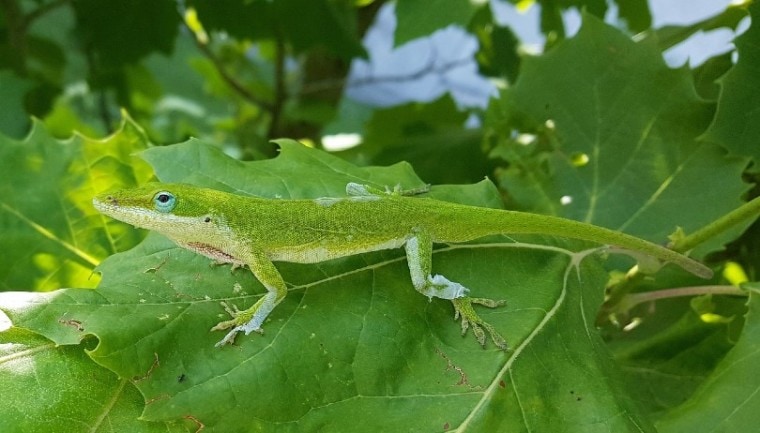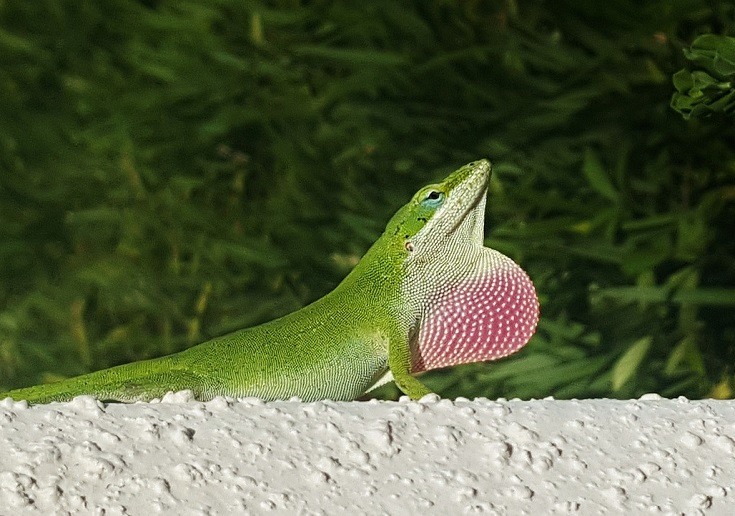
If you’re new to the reptile world, you might not be too familiar with the Green Anole. Also known as the Carolina Anole, this is a great starter reptile pet for either you or your child until you are ready to move onto something a bit more challenging.
But just because this animal is a little easier to care for doesn’t mean you can’t make mistakes. That’s why we came up with this care guide to walk you through everything that you need to know to keep your Green Anole happy and healthy!
Quick Facts about the Green Anole

| Species Name: | Anolis carolinensis |
| Common Name: | Green Anole |
| Care Level: | Beginner |
| Lifespan: | 4 to 6 years |
| Adult Size: | 5 to 8 inches |
| Diet: | Spiders, crickets, flies, moths, butterflies, worms, ants, termites, small slugs, and small beetles |
| Minimum Tank Size: | 10 gallons |
| Temperature & Humidity | Basking area of 85 to 90 degrees Fahrenheit, cool area of 70 to 75 degrees Fahrenheit, 60-70% humidity |
Do Green Anoles Make Good Pets?
If you’re looking for an easy-to-care-for and low-cost pet, the Green Anole can make a great choice. While they’re not the most fun to play with, they are an interesting species to watch.
They’re don’t take up much space compared to other reptiles. If you’re looking for a pet for your child, their shorter lifespan is another great perk.
But remember that while the Green Anole itself is cheap, getting everything that you need to care for them can get expensive.
Just keep in mind that you should never house two male Green Anoles together because they’ll get aggressive and fight each other, even if a female isn’t around.
Appearance
The Green Anole is one of the few lizards that has no morphs or color variations. This means that all Green Anoles look the same. They are smaller lizards, with males only reaching 8 inches in length and females topping out at 6 inches.
Males have a reddish-pink dewlap under their chin, and they all have a bright green appearance when relaxed. When they are stressed, they will turn brown. Typically, once you remove the stressor, the Green Anole will regain their bright green appearance.

How to Take Care of Green Anole
Caring for the Green Anole is relatively easy, but that doesn’t mean you can’t find yourself making rookie mistakes if you don’t know what you’re doing. Here, we highlighted the basic care requirements for the Green Anole.
Habitat, Tank Conditions & Setup
Tank
If you’re housing a single Green Anole, a 10-gallon aquarium should be large enough. The aquarium needs to be at least 18 inches high and have a screened lid; otherwise, the Green Anole will escape from the top of the tank.
You need to elevate the tank off the ground, at least 5 feet up in the air. If the tank is too low, your Green Anole will feel threatened by movement outside the enclosure.
Ensure that there is plenty of space for your Green Anole to climb and enough space for a basking area near the top of the tank.
Lighting
One of the most specific requirements for caring for a Green Anole is their lighting. They need to bask for 12 to 14 hours each day under a UVA and UVB bulb; otherwise, they won’t get the energy that they need to live.

Heating (Temperature & Humidity)
Another huge part of caring for a Green Anole is getting the temperature gradient right. They need a basking area near the top of the tank that reaches between 85 and 90 degrees Fahrenheit, and the bottom of their tank should be a bit cooler, ranging between 70 and 75 degrees Fahrenheit.
In addition to the right temperature gradient, the Green Anole needs a humid environment. Shoot for 60-70% humidity, although they can tolerate humidity levels as low as 50% for a short period.
Maintain the proper humidity level by misting the tank daily.
Substrate
Green Anoles aren’t too picky about their substrate, and you have a few options to choose from. Possible options include reptile carpet, coconut fiber, peat moss with pea gravel, or untreated soil.
You need to spot clean the substrate at least once a week and replace the substrate entirely once a month.
Tank Recommendations
| Tank Type: | 10-gallon tank with a screened lid |
| Lighting: | A UVA and UVB bulb |
| Heating: | 85-to-90-degree-Fahrenheit basking area near the top of the tank, a 70-to-75-degree- Fahrenheit cool area near the bottom of the tank, and between 60% and 70% humidity |
| Best Substrate: | Coconut fiber |
Feeding Your Green Anole
Feeding your Green Anole is another relatively simple task. They don’t demand a varied diet, and you can feed them a mix of mealworms, waxworms, and crickets. It’s best to gut-load the insects before feeding them to your Green Anole.
This means giving the worms and crickets a healthy diet of leafy greens, carrots, oranges, apples, and potatoes before feeding them to your Green Anole. This passes the nutrients onto your Green Anole and keeps them healthier.
While you can mix up worms and crickets, you don’t have to — any one of those insects can make up 100% of their diet. However, you should sprinkle calcium and vitamin supplements over their food, which is much easier to do with worms.
Diet Summary
| Crickets | 70% of diet |
| Mealworm/waxworms | 30% of diet |
| Supplements Required | Calcium and vitamin |
Keeping Your Green Anole Healthy
The Green Anole is an extremely hardy animal that rarely gets sick. However, that doesn’t mean there aren’t any health concerns that you need to look out for.
We highlighted several common health problems here, but the best thing that you can do to keep your Green Anole healthy is to give them a healthy diet, keep up with cage cleanings, and maintain an ideal environment.
If they start to turn brown, it indicates that they are stressed, and there’s likely something in their environment that you need to change. If you notice any of the following conditions, you need to take your Green Anole to a vet as soon as possible.
Common Health Issues
Lifespan
The Green Anole has a much shorter lifespan compared to many other lizards. The average lifespan of a Green Anole is 5 years, but they can live anywhere from 2 to 6 years.
While there’s no way to guarantee that your Green Anole will hit the 5-year mark, one of the best things that you can do is to keep up with their conditions and give them a healthy diet. If you do, there’s a good chance that your Green Anole will live at least that long.
Breeding
Breeding the Green Anole is exceedingly easy. All you need to do is leave a female and male Green Anole in the same enclosure. After mating, the female will lay an egg every 2 weeks for 5 months.
They only lay one egg at a time, but this means you can expect 10 to 11 babies in one season. Incubation only lasts for about 45 days, then the eggs will start to hatch.
You can leave the eggs in the tank to incubate, but we recommend a separate enclosure because Green Anoles are known to cannibalize their young. Since you can’t house multiple males together, you’ll need to separate them as soon as possible after they hatch.

Are Green Anoles Friendly? Our Handling Advice
The best handling advice that we can give you for the Green Anole is to leave them alone. It’s not that they’ll do anything to you — they’re extremely friendly, if a bit skittish. But it’s this skittishness that can lead to problems.
They’re extremely small and easily injured, which means you can’t hold them too tight. However, since they’re so skittish, they’ll try to escape when you hold them. This can easily lead to you squeezing just a bit too tight and hurting or killing your Green Anole.
If you want to interact with your Green Anole, it’s best to do it inside their enclosure and while feeding them. Even if you do everything right, handling your Green Anole will stress them out, and that can create health problems by itself. But if you’re hand-feeding your Green Anole crickets or mealworms, they’ll focus on the food, and it’s far less likely that they’ll stress out.
Shedding & Brumation: What to Expect
Determining how often your Green Anole will shed isn’t an exact science. Some Green Anoles will shed every month, while others only do it about once a year. They do not shed their skin all at once, so don’t be surprised when it comes off in patches.
Their appetite will drop shortly after shedding, and this is completely normal because they eat their own skin for the nutrients!
During the winter months, it’s a good idea to have your Green Anole enter brumation. To do this, simply lower the temperature in the cool part of the tank to 65 to 70 degrees Fahrenheit during the day and 60 degrees Fahrenheit at night.
Feed them slightly less food, and decrease the amount of light in their tank to 8 hours a day. After about 3 months, you can warm the tank back up and slowly bring them out of brumation.
How Much Do Green Anoles Cost?
There’s no shortage of Green Anoles, so you can expect to spend between $5 and $10 for a Green Anole. In fact, these lizards are so affordable, many people opt to use them as feeder food for snakes and other reptiles.
No matter what you’re looking to purchase your Green Anole for, you shouldn’t spend any more than $10 for one.

Care Guide Summary
Final Thoughts
Whether you’re looking for a new companion for your home or a starter pet for your child, the Green Anole makes a great choice. Their color-changing acts like a visible cue if you’re neglecting their care.
They’re docile and easy to care for, which makes them a great addition to many homes!
Featured Image Credit: Brett Hondow, Pixabay








